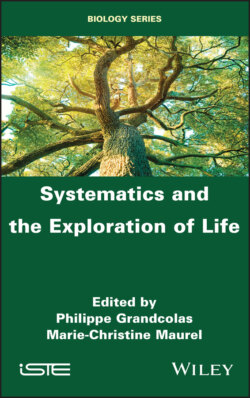Читать книгу Systematics and the Exploration of Life - Группа авторов - Страница 30
2.8. References
ОглавлениеAlberts, B., Bray, D., Lewis, J., Raff, M., Toberts, K., and Watson, J. (1994). Molecular Biology of the Cell. Garland Publishing, New York.
Anfinsen, C.B. (1973). Principles that govern the folding of protein chains. Science, 181, 223–230.
Berman, H.M., Westbrook, J., Feng, Z., Gilliland, G., Bhat, T.N., Weissig, H., Shindyalov, I.N., and Bourne, P.E. (2000). The Protein Data Bank. Nucleic Acids Research, 28, 235–242.
Bloom, J.D., Raval, A., and Wilke, C.O. (2007). Thermodynamics of neutral protein evolution [Online]. Genetics, 175, 255–266. Available: https://doi.org/10.1534/genetics.106.061754.
Bordner, A.J. and Abagyan, R.A. (2004). Large-scale prediction of protein geometry and stability changes for arbitrary single point mutations [Online]. Proteins, 57, 400–413. Available: https://doi.org/10.1002/prot.20185.
Bressler, S. and Talmud, D. (1944). On the nature of globular proteins. Comptes rendus de l’Académie des sciences de l’URSS, 43, 310–314.
Davis, I.W., Arendall, W.B., Richardson, D.C., and Richardson, J.S. (2006). The backrub motion: How protein backbone shrugs when a sidechain dances [Online]. Structure, 14, 265–274. Available: https://doi.org/10.1016/j.str.2005.10.007.
DePristo, M.A., Weinreich, D.M., and Hartl, D.L. (2005). Missense meanderings in sequence space: A biophysical view of protein evolution [Online]. Nature Reviews Genetics, 6, 678–687. Available: https://doi.org/10.1038/nrg1672.
Dunbrack, R.L. (2002). Rotamer libraries in the 21st century [Online]. Current Opinion in Structural Biology, 12, 431–440. Available: https://doi.org/10.1016/S0959-440X(02)00344-5.
Gong, S., Worth, C.L., Bickerton, G.R.J., Lee, S., Tanramluk, D., and Blundell, T.L. (2009). Structural and functional restraints in the evolution of protein families and superfamilies [Online]. Biochemical Society Transactions, 37, 727–733. Available: https://doi.org/10.1042/BST0370727.
Gromiha, M.M. and Sarai, A. (2010). Thermodynamic database for proteins: Features and applications [Online]. Methods in Molecular Biology, 609, 97–112. Available: https://doi.org/10.1007/978-1-60327-241-4_6.
Guerois, R., Nielsen, J.E., and Serrano, L. (2002). Predicting changes in the stability of proteins and protein complexes: A study of more than 1000 mutations [Online]. Journal of Molecular Biology, 320, 369–387. Available: https://doi.org/10.1016/S0022-2836(02)00442-4.
Guo, H.H., Choe, J., and Loeb, L.A. (2004). Protein tolerance to random amino acid change [Online]. Proceedings of the National Academy of Sciences, 101, 9205–9210. Available: https://doi.org/10.1073/pnas.0403255101.
Kellogg, E.H., Leaver-Fay, A., and Baker, D. (2011). Role of conformational sampling in computing mutation-induced changes in protein structure and stability [Online]. Proteins, 79, 830–838. Available: https://doi.org/10.1002/prot.22921.
Kosloff, M. and Kolodny, R. (2008). Sequence-similar, structure-dissimilar protein pairs in the PDB [Online]. Proteins, 71, 891–902. Available: https://doi.org/10.1002/prot.21770.
Lauck, F., Smith, C.A., Friedland, G.F., Humphris, E.L., and Kortemme, T. (2010). RosettaBackrub – A web server for flexible backbone protein structure modeling and design [Online]. Nucleic Acids Research, 38, W569–W575. Available: https://doi.org/10.1093/nar/gkq369.
Lonquety, M., Lacroix, Z., Papandreou, N., and Chomilier, J. (2009). SPROUTS: A database for the evaluation of protein stability upon point mutation [Online]. Nucleic Acids Research, 37, D374-9. Available: https://doi.org/10.1093/nar/gkn704.
Luzzati, V. (1952). Traitement statistique des erreurs dans la determination des structures cristallines [Online]. Acta Crystallographica, 5, 802–810. Available: https://doi.org/10.1107/S0365110X52002161.
Religa, T.L., Markson, J.S., Mayor, U., Freund, S.M.V., and Fersht, A.R. (2005). Solution structure of a protein denatured state and folding intermediate [Online]. Nature, 437, 1053–1056. Available: https://doi.org/10.1038/nature04054.
Sander, C. and Schneider, R. (1991). Database of homology-derived protein structures and the structural meaning of sequence alignment [Online]. Proteins, 9, 56–68. Available: https://doi.org/10.1002/prot.340090107.
Schaefer, C. and Rost, B. (2012). Predict impact of single amino acid change upon protein structure [Online]. BMC Genomics, 13, S4. Available: https://doi.org/10.1186/1471-2164-13-S4-S4.
Shakhnovich, E.I. and Gutin, A.M. (1991). Influence of point mutations on protein structure: Probability of a neutral mutation. J. Theor. Biol., 149, 537–546.
Shanthirabalan, S., Chomilier, J., and Carpentier, M. (2018). Structural effects of point mutations in proteins [Online]. Proteins: Structure, Function, and Bioinformatics, 86, 853–867. Available: https://doi.org/10.1002/prot.25499.
Stryer, L. (1994). Biochemistry. W.H. Freeman, New York.
Studer, R.A., Dessailly, B.H., and Orengo, C.A. (2013). Residue mutations and their impact on protein structure and function: Detecting beneficial and pathogenic changes [Online]. Biochemical Journal, 449, 581–594. Available: https://doi.org/10.1042/BJ20121221.
Taverna, D.M. and Goldstein, D. (2002). Why are proteins marginally stable? [Online]. Proteins, 46(1), 105–109. Available: https://doi.org/10.1002/prot.10016.
Zeldovich, K.B., Chen, P., and Shakhnovich, E.I. (2007). Protein stability imposes limits on organism complexity and speed of molecular evolution [Online]. Proceedings of the National Academy of Sciences, 104, 16152–16157. Available: https://doi.org/10.1073/pnas.0705366104.
Zhou, R., Eleftheriou, M., Royyuru, A.K., and Berne, B.J. (2007). Destruction of long-range interactions by a single mutation in lysozyme [Online]. Proceedings of the National Academy of Sciences, 104, 5824–5829. Available: https://doi.org/10.1073/pnas.0701249104.
1 1 Or peptides, which are chains containing less than 50 amino acids linked by peptide bonds.
Chapter written by Mathilde CARPENTIER and Jacques CHOMILIER.
